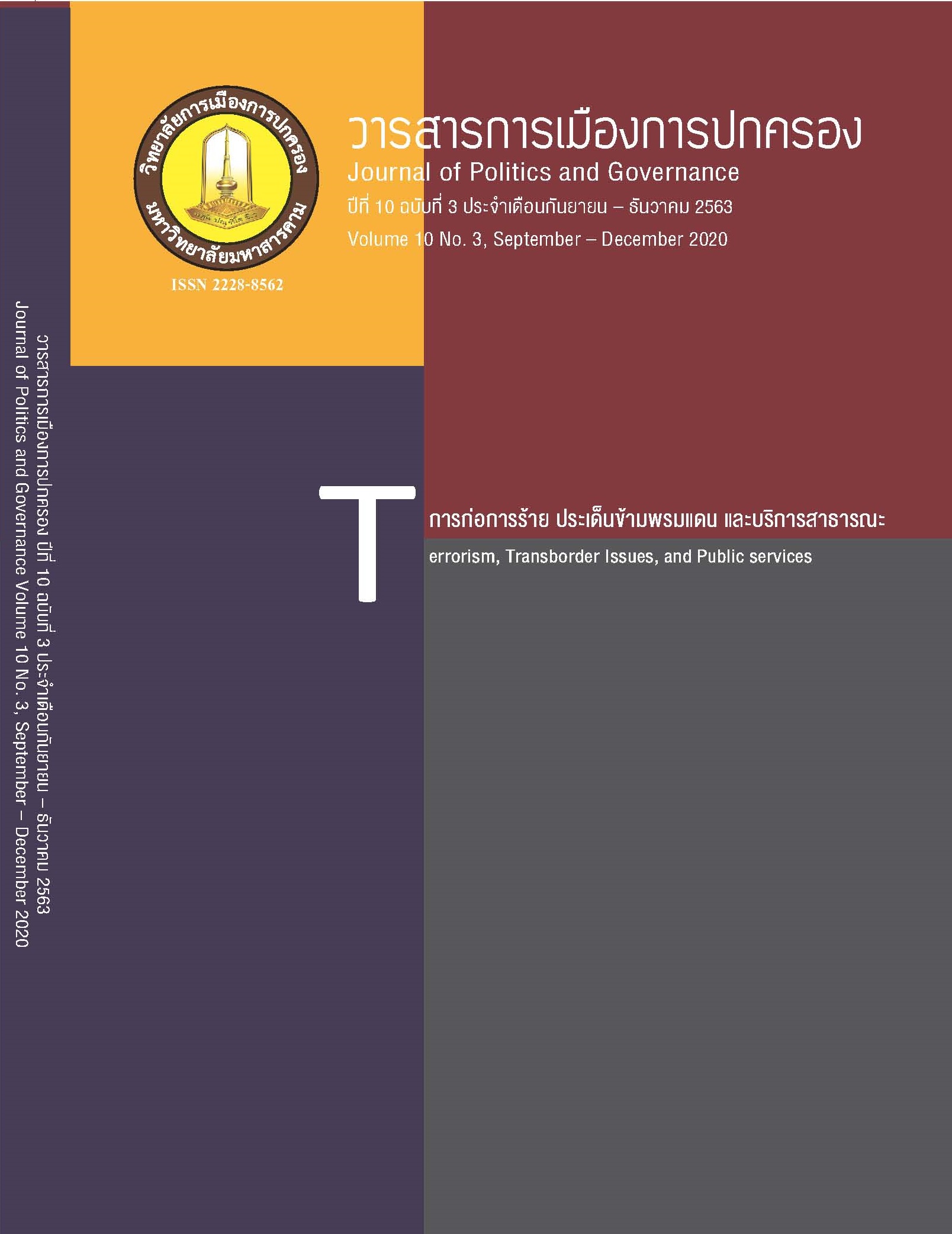The Developing Model of the Elderly’s Quality of Life Policy: Surin Province Case Study
Main Article Content
Abstract
The objectives of this research were to 1) study the elderly’s quality of life in Surin province, 2) study the factors, that affects the elderly’s quality of life in Surin province and 3) to create the development model of the elderly’s quality of life in Surin province policy. Instruments used were WHOQOL-BREF-THAI questionnaire with the reliability value of 0.84. Samples were elderly population totally 399 subjects. Statistics used were; frequency, percentage, means, standard deviation, Pearson’s product moment correlation and multiple linear regression. The research results indicated that the elderly’s quality of life in Surin province, in overall, was found in medium mean level. Considering in each component found that 3 components were in medium level and 1 component was in least level, arranged by order from most to least were; environment aspect, mental aspect, health aspect and social relationship aspect while factors affecting the elderly’s quality of life in Surin province statistically were 8 factors, arranged by order with the standardized coefficient beta from most to least were; creative factor (β = 0.50), chronic disease factor (β = 0.34), social support factor (β = 0.21), eating factor (β = 0.19), marital status factor (β = 0.11), living factor (β = 0.11), age factor (β = (-0.10) and education factor (β = 0.07). The development model creation of the elderly’s quality of life in Surin province policy were consisted of elderly’s quality of life development method in local and province level, totally 12 developing activities.
Article Details
References
เขมิกา ยามะรัตน์. (2557). ความพึงพอใจในชีวิตของคนชรา: กรณีข้าราชการบำนาญกระทรวงเกษตรและสหกรณ์. วิทยานิพนธ์ปริญญาสังคมศาสตรมหาบัณฑิต. กรุงเทพฯ: มหาวิทยาลัยธรรมศาสตร์.
ดุษฎี อายุวัฒน์. (2558). มาตรวัดคุณภาพชีวิต : ศึกษากรณีประชาชนในภาคตะวันออกเฉียงเหนือของประเทศไทย. รายงานการวิจัย. กรุงเทพฯ: จุฬาลงกรณ์มหาวิทยาลัย.
พรเทพ ศิริวนารังสรรค์ และคณะ. (2556). รายงานการสำรวจสภาวะสุขภาพผู้สูงอายุไทยปี 2556. กรุงเทพฯ: กระทรวงสาธารณสุข, กรมอนามัย.
พระราชบัญญัติผู้สูงอายุ พ.ศ. 2546 (พิมพ์ครั้งที่ 4). กรุงเทพฯ: เจ. เอส. การพิมพ์.
เพ็ญนภา กาญจโนภาส. (2551). ประสิทธิผลของโปรแกรมสุขศึกษาเกี่ยวกับพฤติกรรมการส่งเสริมสุขภาพในการดูแลตนเองของผู้สูงอายุ อำเภอหนองบัวระเหว จังหวัดชัยภูมิ. วิทยานิพนธ์ปริญญาสาธารณสุขศาสตรมหาบัณฑิต. กรุงเทพฯ: มหาวิทยาลัยศรีนครินทรวิโรฒ.
ภัทรพงษ์ เกตุคล้าย และวิทัศน์ จันทวโพธิศร. (2555). ปัจจัยที่มีความสัมพันธ์กับคุณภาพชีวิตของผู้สูงอายุที่ได้รับเบี้ยยังชีพอำเภอพรรณานิคม จังหวัดสกลนคร. สำนักงานป้องกันควบคุมโรคที่ 6, 19(2), 55-64.
ศรีทับทิม รัตนโกศล. (2557). สัมพันธภาพที่ดีในครอบครัว. กรุงเทพฯ: มหาวิทยาลัยธรรมศาสตร์.
สมจิตต์ ศิริวนารังสรรค์ และ เสน่ห์ แสงเงิน. (2559). รูปแบบการพัฒนาคุณภาพชีวิตของผู้สูงอายุในชนบท จังหวัดสุโขทัย. รายงานการวิจัย. กรุงเทพฯ:
สำนักงานพัฒนาชุมชนอำเภอเมืองสุรินทร์. (2560). คุณภาพชีวิตของคนอำเภอเมืองสุรินทร์. รายงานการวิจัย. สุรินทร์: กรมการพัฒนาชุมชน.
สำนักงานสถิติแห่งชาติ. (2559). สถิติผู้สูงอายุประเทศไทย พ.ศ. 2558-2562. กรุงเทพฯ: ศูนย์เทคโนโลยี.
สุภาพ ไทยแท้. (2559). ความสัมพันธ์ระหว่างปัจจัยส่วนบุคคล ปัจจัยด้านสถานการณ์และการรับรู้บทบาทกับการปฏิบัติบทบาทอาจารย์ที่ปรึกษาของพยาบาล. วิทยานิพนธ์ปริญญาพยาบาลศาสตรมหาบัณฑิต. กรุงเทพฯ: จุฬาลงกรณ์มหาวิทยาลัย.
อนุชา ขุนเมือง. (2556). พฤติกรรมการดูแลตนเองด้านจิตใจของผู้สูงอายุในชมรมผู้สูงอายุจังหวัดสระแก้ว. วิทยานิพนธ์ปริญญาสาธารณสุขศาสตรมหาบัณฑิต มหาวิทยาลัยเชียงใหม่.
อรชุมา พุ่มสวัสดิ์. (2559). การเปรียบเทียบการเห็นคุณค่าในตนเองของเด็กวัยรุ่นที่ได้รับการอบรมเลี้ยงดู ในรูปแบบที่แตกต่างกันตามการรับรู้ของตนเอง. วิทยานิพนธ์ปริญญาพยาบาลศาสตรมหาบัณฑิตจุฬาลงกรณ์มหาวิทยาลัย.
Coopersmith, S. (1992). The antecedent of self-esteem Palo Alpo. New York: Westers press.
Cronbach, J. (1990). Essentials of Psychology Testing. New York: Harper Collins.
House, J.S. (1981). Work stress and social Support. New Jersey: Prentice Hall.
Likert, R. (1967). Research Methodology and Measurement. New York: McGraw Hill.
Orem, D.E. (1991). Nursing concepts of Practice (4th ed). St. Louis: Mosby – Book.
Pender, N.J. (1987). Health Promoting in Nursing Practice. Norwalk: Appleton & Lange
World Health Organization. Expert Committee. (1995). The Development of the World Health Organization Quality of Life Assessment Instrument. Geneva: WHO.
Yamane, T. (1973). Statistics: An Introductory Analysis. New York: Harper and Row.


